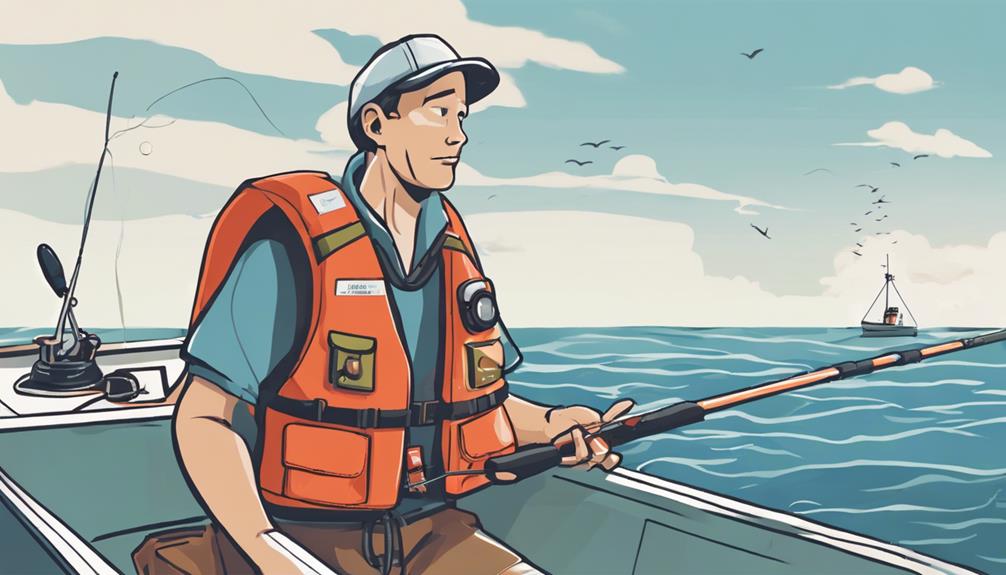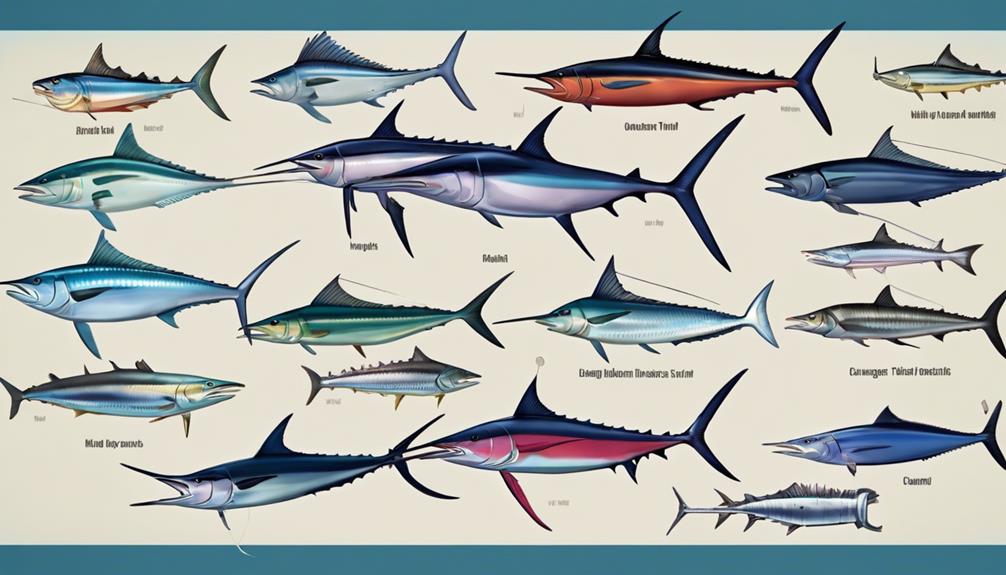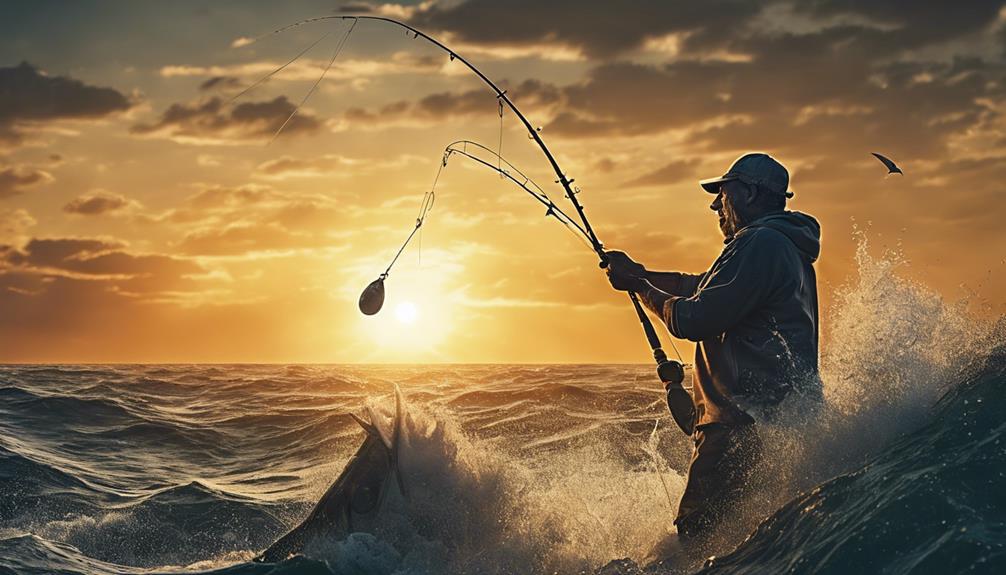Did you know that deep sea fishing is considered one of the most thrilling outdoor activities, attracting millions of enthusiasts each year? Ensuring your safety while embarking on this adventure is paramount.
From understanding proper gear and equipment to having an emergency communication plan in place, these 13 key safety tips will help you navigate the open waters with confidence.
But before you set sail, there are crucial aspects to consider that could make all the difference in your deep sea fishing experience.
Proper Gear and Equipment
To ensure a safe and successful deep-sea fishing trip, equip yourself with the proper gear and equipment. When selecting bait, it's essential to consider the type of fish you aim to catch. Different fish species are attracted to specific types of bait, so research on the common fish in the area you plan to fish in. Live bait such as squid, mackerel, or sardines are often effective choices. Make sure to also pack artificial lures in case live bait isn't readily available or preferred.
Next, familiarize yourself with various fishing techniques. Deep-sea fishing requires different techniques compared to freshwater or shallow water fishing. One common technique is trolling, where you slowly drive the boat while trailing baited lines behind. This method is great for catching fast-moving fish like tuna or marlin. Jigging is another effective technique where you drop a weighted lure up and down in the water to attract fish. Bottom fishing involves dropping bait to the ocean floor to catch bottom-dwelling species like grouper or snapper.
Weather Awareness
Stay vigilant and informed about weather conditions before heading out for your deep-sea fishing excursion. Storm monitoring is crucial to ensure your safety on the water. Always check weather forecasts from reliable sources and be aware of any potential storms in the area. If there are storm warnings or adverse weather conditions predicted, it's best to postpone your fishing trip to avoid putting yourself and others at risk.
Understanding wind patterns is essential for deep-sea fishing. Strong winds can create rough seas, making navigation challenging. Before setting out, familiarize yourself with wind forecasts and how they may affect your fishing expedition. Adjust your navigation strategies accordingly to ensure a smoother and safer trip. It's also advisable to have a backup plan in case conditions worsen unexpectedly.
Safety protocols should always be in place to deal with changing weather conditions. Have a clear plan of action in case you encounter a storm while out at sea. Make sure all passengers on board are aware of safety procedures and know where to find life jackets and emergency equipment. Stay alert and be prepared to act swiftly if the weather takes a turn for the worse. By staying informed and following proper safety measures, you can enjoy your deep-sea fishing adventure while minimizing risks.
Safety Briefing Before Departure
Before embarking on your deep-sea fishing trip, ensure a comprehensive safety briefing is conducted for all passengers onboard. This briefing is crucial to familiarize everyone with the safety protocols and emergency procedures in case of unexpected situations. Here are key points to cover in the safety briefing:
- Pre-Trip Checklist: Make sure all passengers are aware of the pre-trip checklist, including items like life jackets, emergency equipment locations, and communication devices.
- Safety Protocols: Explain the safety protocols on the boat, such as how to move around safely, where to assemble in case of emergencies, and how to use safety equipment.
- Emergency Procedures: Detail the steps to follow in case of emergencies like man overboard, fire onboard, or severe weather conditions.
- Communication Plan: Review the communication plan onboard, including how to contact the crew in emergencies and the use of distress signals.
- First Aid Kit Location: Ensure all passengers know the location of the first aid kit and how to use basic supplies for minor injuries.
Emergency Communication Plan
Ensure all passengers are familiar with the emergency communication plan onboard the vessel to effectively respond to any unforeseen situations. In the event of an emergency while deep sea fishing, having a clear plan in place can make a significant difference in ensuring everyone's safety. One crucial aspect of this plan is designating an emergency contact person onshore who can be reached in case of emergencies. Make sure all passengers are aware of who this contact person is and how to reach them.
Communication devices play a vital role in emergency situations. Before setting out for deep sea fishing, ensure that all communication devices onboard, such as marine radios, satellite phones, or cell phones, are functioning correctly and that passengers know how to operate them. It's essential to have redundant communication methods in case one fails to work.
Establish a protocol for using communication devices during emergencies. Designate specific individuals to handle different types of communication equipment to avoid confusion. Practice using these devices before departing so that everyone is comfortable with their operation. Additionally, ensure that all passengers know where the communication devices are stored on the vessel and how to access them quickly if needed.
Knowledge of Boat Layout
Familiarize yourself with the layout of the boat to navigate efficiently and locate important safety equipment easily. Understanding the boat's layout is crucial for a successful and safe deep-sea fishing experience. Here are some essential tips to help you familiarize yourself with the boat's layout:
- Study the Boat Map: Take some time to review the boat's map or layout provided by the crew. This will give you an overview of where everything is located.
- Identify Emergency Equipment: Locate the emergency equipment such as life jackets, fire extinguishers, and first aid kits. Knowing their positions beforehand can save valuable time in case of an emergency.
- Learn About Fishing Stations: Get to know the fishing stations on the boat. Different areas may be designated for specific types of fishing techniques or equipment.
- Understand Navigation Areas: Familiarize yourself with the navigation areas of the boat. This includes knowing where the captain operates the vessel and understanding basic boat navigation terms.
- Ask for Guidance: If you're unsure about anything related to the boat's layout, don't hesitate to ask the crew for guidance. They're there to ensure your safety and enjoyment during the fishing trip.
Understanding Sea Conditions
To ensure a safe and enjoyable deep-sea fishing experience, understanding the current sea conditions is essential. Sea currents and wind patterns play a significant role in determining the overall safety and success of your fishing trip. Before heading out, it's crucial to check the marine forecast to get an idea of what to expect. Strong sea currents can make navigation challenging, especially for inexperienced anglers. It's important to be aware of any potential changes in currents throughout the day to avoid getting caught in a dangerous situation.
Wind patterns are another important factor to consider when planning your deep-sea fishing excursion. Winds can affect the stability of the boat and the comfort of everyone on board. Pay attention to the direction and speed of the wind to anticipate any rough conditions that may arise. In case of strong winds, it's advisable to stay closer to the shore or seek sheltered areas to avoid rough waters.
Being knowledgeable about sea currents and wind patterns not only enhances your safety but also improves your chances of having a successful fishing trip. By staying informed and prepared, you can navigate the waters with confidence and enjoy a memorable deep-sea fishing experience.
First Aid Kit Essentials

Pack your deep-sea fishing first aid kit with essential supplies to be prepared for any potential injuries or emergencies while out at sea. When out on the open water, it's important to have the necessary items to handle emergency situations effectively.
Here are some key essentials to include in your first aid kit:
- Sterile Gauze Pads: These are crucial for wound care and can help stop bleeding in case of cuts or scrapes.
- Adhesive Bandages: Useful for covering minor cuts or blisters to prevent infections.
- Antiseptic Wipes: Important for cleaning wounds before dressing them to prevent infection.
- Tweezers: Handy for removing splinters, ticks, or debris from wounds to prevent further complications.
- Instant Cold Packs: These can help reduce swelling and soothe minor injuries like bruises or sprains.
In case of emergencies, having a well-equipped first aid kit can make a significant difference in your ability to provide immediate care. Remember to check your kit regularly and replace any items that have been used or have expired.
Being prepared with the right supplies for emergency response and wound care can ensure a safer and more enjoyable deep-sea fishing experience.
Sun Protection Measures
Ensure your skin is adequately protected from the sun's harmful rays by following these essential sun protection measures during your deep-sea fishing expedition.
Start by applying a broad-spectrum sunscreen with an SPF of 30 or higher, remembering to reapply every two hours or more frequently if you're sweating heavily or swimming. Sunscreen application is crucial to prevent sunburns and reduce the risk of skin cancer.
Additionally, keep yourself hydrated by drinking plenty of water throughout the day to avoid dehydration and heat exhaustion.
Wearing protective clothing such as long-sleeved shirts, wide-brimmed hats, and UV-blocking sunglasses can offer added defense against the sun. Lightweight and breathable fabrics will help keep you cool while shielding your skin from harmful UV rays.
Seek shade whenever possible, especially during the peak sun hours between 10 a.m. and 4 p.m. If your boat lacks sufficient shade options, consider bringing along a portable umbrella or canopy to create your own shaded area.
Frequently Asked Questions
What Are the Best Practices for Handling Fish Once They Are Caught to Ensure Their Safety and Wellbeing?
When handling fish you've caught, it's crucial to prioritize their safety and wellbeing. Implementing proper fish handling techniques is essential for conservation efforts. Remember to handle fish with care and avoid causing harm.
Use safety measures to ensure both your safety and the fish's protection. By following best practices in fish handling, you contribute to the conservation of marine life and promote the sustainability of fishing practices.
How Can Deep Sea Fishermen Protect Themselves From Potential Encounters With Marine Wildlife, Such as Sharks or Stingrays?
When out at sea, protect yourself from marine wildlife encounters by staying alert and following safety measures.
Prevent shark or stingray encounters by avoiding swimming in murky waters and refraining from feeding wildlife. Take precautions such as not wearing shiny jewelry or dangling clothing that may attract marine animals.
Be prepared with proper gear like shark repellents and first aid kits.
Stay informed about the area's wildlife and follow guidelines to ensure your safety.
Are There Any Specific Regulations or Guidelines for Disposing of Fishing Waste and Byproducts While Out at Sea?
When out at sea, it's crucial to follow proper disposal guidelines for fishing waste to minimize the environmental impact.
Make sure to store trash securely on board and dispose of it properly when you return to land.
Avoid throwing waste overboard, as it can harm marine life and pollute the ocean.
What Steps Should Be Taken to Prevent Seasickness While Deep Sea Fishing, and What Are Some Effective Remedies in Case It Occurs?
To prevent seasickness while deep sea fishing, start by choosing a larger boat for stability and sit near the center. Keep your eyes on the horizon and avoid strong odors. Stay hydrated and avoid heavy meals before boarding.
If seasickness strikes, try ginger candies or wristbands, or consult a doctor for medication. Remember to stay calm and focus on the experience rather than the discomfort.
How Can Deep Sea Fishermen Ensure They Are Not Contributing to Overfishing or Damaging Marine Ecosystems During Their Fishing Trips?
To ensure you're not contributing to overfishing or harming marine ecosystems, follow sustainable practices. Limit your catch to legal limits and avoid taking more than you need.
Support conservation efforts by releasing non-target species unharmed and using circle hooks to reduce harm to marine life.
Be mindful of the marine biodiversity you encounter and strive to protect ecosystems by respecting marine protected areas and following guidelines for responsible fishing practices.
Conclusion
Stay safe out on the water by following these 13 key safety tips for deep sea fishing.
Remember to always be prepared with the proper gear and equipment.
Stay informed about weather conditions and have a plan in case of emergencies.
With the right precautions and knowledge, you can enjoy a successful and safe deep sea fishing adventure.
Happy fishing!



